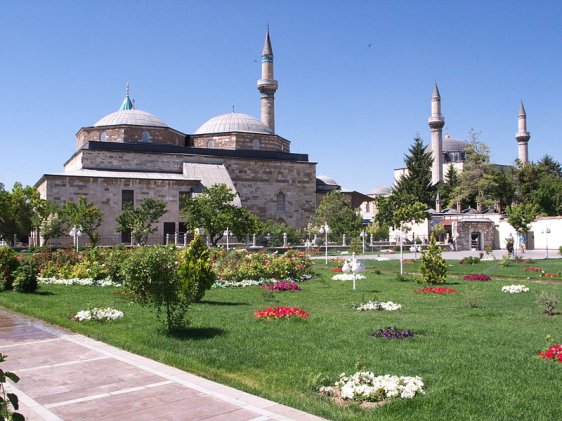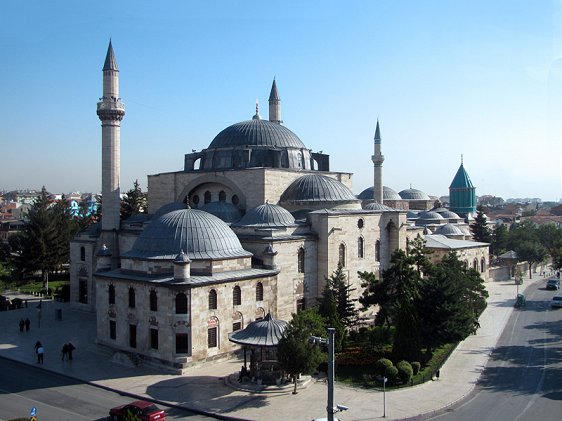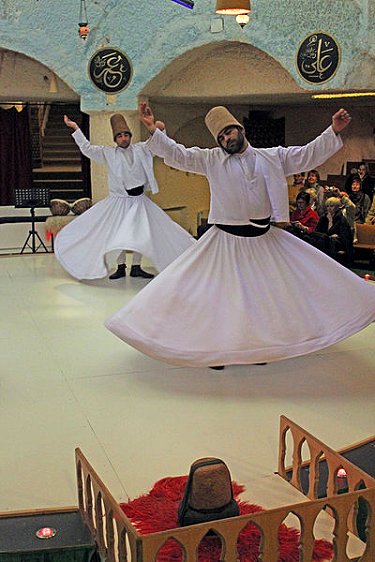Konya is the 7th biggest city in Turkey. Its metropolitan area encompasses the whole Konya Province in the Central Anatolia Region. The metropolitan area of Konya has a population of one million people (2011 estimate).
The name Konya is derived from the word Ἰκόνιον in Greek, the same word that gives us "icon". During ancient times, it was called Iconium. The city has a recorded history going back to the times of the Hittites around 1,500 BC, with evidence of human habitation reaching back to the Copper Age, around 3,000 BC.
 Mevlâna Museum, Konya
Mevlâna Museum, KonyaSource: https://commons.wikimedia.org/wiki/File:Convento_de_Mevlana._Zawiye.jpg
Author: José Luis Filpo Cabana
Author: José Luis Filpo Cabana

In the 8th century BC, the Konya area was ruled by the Phrygians. At that time, the city was called Iconium. Cimmerian invaders captured it in 690 BC, making it part of the Persian Empire until Darius III was defeated by Alexander the Great in 333 BC, starting the Hellenistic period in the city. The last king of Pergamon, Attalus III, bequethed his kingdom to Rome, bringing Roman rule over Iconium.
In the Bible's New Testament, Paul and Barnabas preached in Iconium on Paul's First Missionary Journey around AD 47-48, as mentioned in Acts 14:1-5 and Acts 14:21. Paul probably visited it again during his Second Missionary Journey in AD 50, in the company of Silas (Acts 16:2).
 Alaeddin Mosque, Konya
Alaeddin Mosque, KonyaSource: https://commons.wikimedia.org/wiki/File:Konya,_Turkey_-_Mosque-museum_Alaaddin.jpg
Author: Gilles MAIRET
Author: Gilles MAIRET

In 1071, Iconium was conquered by Seljuk Turks, and with it came Muslim rule of the city. In 1134, the name Iconium was changed to Konya. In 1220 it received an influx of refugees fleeing Mongol invasion of the Khwarezmid Empire. Konya came under the rule of the Ottoman Empire in 1453, and this led to it being part of modern Turkey6 today.
 Whirling dervishes, Konya
Whirling dervishes, KonyaSource: https://commons.wikimedia.org/wiki/File:06_DervichesTourneursKonyaDanse4.jpg
Author: Claude Valette
Author: Claude Valette

The city of Konya experiences a continental climate. The wettest months in the city are in spring and autumn. Warmest months are July and August, with average high temperature of 30.3°C (86.5°F). Coldest month is January, when the average low temperature drops to -4.1°C (24.6°F). Konya is semi-arid with total annual precipitation of only 330 mm (13 in). Wettest month is December (43.2 mm, 1.7 in) followed by May (41.1 mm, 1.62 in).
Visiting Konya
There are flights to Konya Airport (KYA) from Istanbul. During the summer months, there are also periodic flights from the Netherlands, Germany, Norway and Denmark. A shuttle bus from the airport to downtown Konya takes 30 minutes and costs 9 TL.Sights & Attractions in Konya
- Alaeddin Mosque: A beautiful mosque located at the center of Alaeddın Bulvari.
- Karatay Museum: Museum showcasing an exquisite emsemble of ceramics and tiles. It is housed in the former Great Karatay Seminary established in the 13th century.
- Konya Fairground: Although no longer used for fairs, the fairground is today a popular park in Konya.
- Mevlâna Museum (Mevlâna Müzesi)
Museum celebrating the founder of the Mevlevi dervish sect that produces the whirling dervishes. He is regarded as one of the greatest mystics of the Islamic world. - Ottoman House: A three-story historic house built during the late Ottoman period.
- Villa of Sultan Kılıç Arslan: What was once a villa is now almost lost except for the arching covers sheltering it.
 Latest updates on Penang Travel Tips
Latest updates on Penang Travel Tips
 Map of Roads in Penang
Map of Roads in Penang
Looking for information on Penang? Use this Map of Roads in Penang to zoom in on information about Penang, brought to you road by road.
Copyright © 2003-2025 Timothy Tye. All Rights Reserved.

 Go Back
Go Back